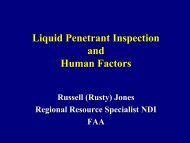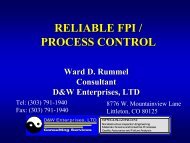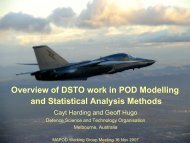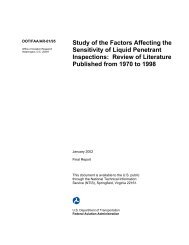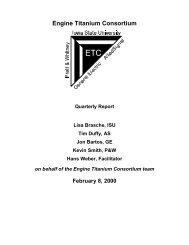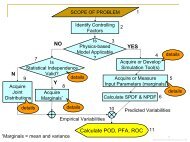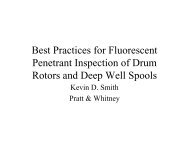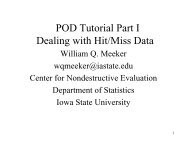Engine Titanium Consortium - Center for Nondestructive Evaluation ...
Engine Titanium Consortium - Center for Nondestructive Evaluation ...
Engine Titanium Consortium - Center for Nondestructive Evaluation ...
You also want an ePaper? Increase the reach of your titles
YUMPU automatically turns print PDFs into web optimized ePapers that Google loves.
Project 3:<br />
Task 3.1:<br />
Subtask 3.1.2:<br />
Inspection Systems Capability<br />
Assessment and Validation<br />
POD Methodology Applications<br />
POD of Ultrasonic Inspection of<br />
<strong>Titanium</strong> Forgings<br />
Team Members:<br />
HW: Tim Duffy, Andy Kinney, Waled<br />
Hassan<br />
GE: Dick Burkel, Bob Gilmore, Jon Bartos,<br />
Dave Copley, Walt Bantz, Ed Nieters<br />
ISU: Thomas Chiou, Bill Meeker, Bruce<br />
Thompson, Lisa Brasche<br />
PW: Jeff Umbach, Kevin Smith, Taher<br />
Aljundi<br />
Students: none<br />
Program initiation date: June 15, 1999. All ef<strong>for</strong>t was stopped on March 17, 2000; On March 14,<br />
2001, guidance was received regarding resumption of the technical work on subtask 3.1.2 with the<br />
initial activity being the revision of program schedules and technical path to account <strong>for</strong> the RDB<br />
results.<br />
Objectives:<br />
• To extend the SNR-based methodology developed in Phase I to predict the POD of naturally<br />
occurring defects in titanium, sonic-shaped <strong>for</strong>gings <strong>for</strong> commonly used ultrasonic procedures<br />
and geometries.<br />
• To further extend the POD methodology to <strong>for</strong>gings of final shape, including the prediction of<br />
POD as a function of position within the part.<br />
• To provide the OEM’s with a set of tools which they can use to implement the new methodology<br />
in internal analysis of POD of <strong>for</strong>gings by increasing the user-friendliness of the methodology<br />
software and flaw and noise response models <strong>for</strong> <strong>for</strong>ging conditions. Included are<br />
improvements in speed, accuracy, range of cases treated and reduction in the amount of<br />
experimental data required.<br />
• To improve the reliability of experimental methods <strong>for</strong> detecting flaws in sonic-shaped <strong>for</strong>gings<br />
and final-shaped, machined parts by developing and validating tools which allow evaluation of<br />
the likely effect on POD of proposed changes in inspections systems and procedures such as<br />
scan plans, transducer properties, gate widths, etc.<br />
• To verify that the new methodology produces POD results which are comparable with results<br />
from existent methodologies in cases when sufficient data is available that the existent<br />
methodologies can be successfully applied and which are consistent with reasonable<br />
expectations when such data is not available.<br />
• To provide the best available estimates of titanium <strong>for</strong>ging POD to the aircraft engine industry,<br />
by means of periodically updating existing estimates based on new in<strong>for</strong>mation, as it becomes<br />
available. This will include incorporating new flaw data, and extending the POD estimates to a<br />
wider range of typical <strong>for</strong>gings geometries through use of the ISU physical models.<br />
Quarterly Report – January 1, 2002 –March 31, 2002<br />
print date/time: 6/6/2002 - 8:39 AM – Page 98



